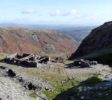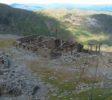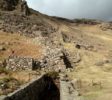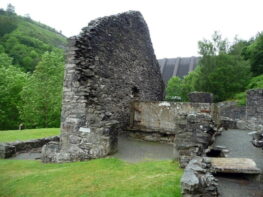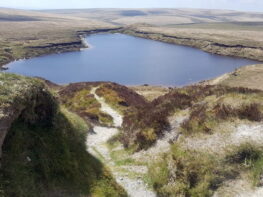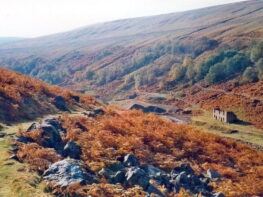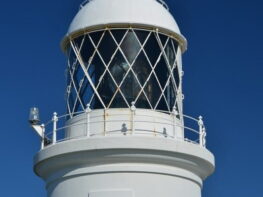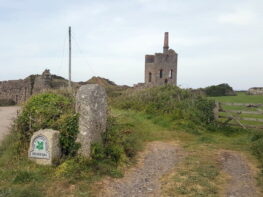
The Coniston Copper Mines has Surface and subterranean remains of a major 19th century copper mining industry, in beautiful Lakeland scenery.
The history of the copper mines go back over 400 years, but extraction of copper will go back much further than this, probably to Roman times or even earlier!
Mining really took off at Coniston when mining experts from Germany arrived in 1563.
The Macclesfield Company went for it in the 1750s, led by Charles Roe. The largely vertical workings following the Bonsor Vein were deepened to over 110m – aided by the construction of a waterwheel and the use of gunpowder.
In the early 19th Century , John Taylor (a famous mining engineer) came to Coniston and shook things up again. He sank shafts and drove drainage adits as well as constructing a system of leats. These leats collected and diverted water around the site.
By the mid 19th century the Coniston mines were reaching their peak period, and some of the deepest workings were approaching 270m.
They had to transport the ore via horse and cart and then floated it on the Ulverston Canal to reach the smelters. But it was such a prolific mine, that when the railways came calling, Coniston commanded a branch line from Furness.
The decline started during the 1860s. Some of the deepest workings now had a surface to bottom difference of 550m!
So when the prices slumped, the pumps stopped and the mine filled up, presumably to adit level. Some reprocessing occurred, by electrolysis of the surface dumps and a bit of shallow level workings, but it completely stopped circa 1940.
The primary minerals found at Coniston are arsenopyrite, chalcopyrite, iron pyrites, malachite, tennantite and tetrahedrite. In the early days of working, the miners favoured malachite due to its easier smelting characteristics. Some veins were so rich in chalcopyrite that the only treatment required was crushing to a manageable size!
The blue formations that Coniston is so famous for are secondary copper mineralisations. Acidic surface water working its way down through the ground and into untapped ore bodies dissolves the minerals and causes crystallisation of the colourful copper formations. This makes Coniston a ‘mecca’ for mineral-hunters!
The underground workings at Coniston Copper Mines are dangerous and strictly for suitably equipped and guided explorers, but the surface remains are accessible to hill walkers.
The restorations and remains are thanks to the Cumbria Amenity Trust Mining History Society (CATMHS). They have been working diligently to research, conserve and preserve the great copper mines for our us all to enjoy at Coniston. The good old Time Team also did some archaeological work here – largely to discover the Tudor workings. Some carbon dating of a wooden door lintel came in at 1490 – so could this have been workings from before the German mining masters in 1563 or were there more that came earlier? – Hmmmm?
To fully immerse yourself in the Coniston mountains you might consider staying at the YHA Coniston Copper Mine Cottage. It certainly provides you more time to explore the surface remains. One thing is for sure and that’s one day here is not enough – especially if you wish to scale the Old Man of Coniston (a mountain peak).
Just to confuse matters – there was a significant amount of slate mining in the region as well!
More information can be found at the nearby Ruskin Museum in Coniston. They have a website HERE! with additional information. Interestingly they also stress the importance of not going into these mines. With a guide is one thing, but never on your own! There are unidentifiable false floors (eg covered in rubble and look like the rest of the ground) that are unstable and covering huge underground voids!
Surface remains include ruined buildings, inclines, wheel pits, shafts, adits and tramways – enjoy!
Coniston, Cumbria, LA21 8HP

The Coniston Copper Mines has Surface and subterranean remains of a major 19th century copper mining industry, in beautiful Lakeland scenery.
The history of the copper mines go back over 400 years, but extraction of copper will go back much further than this, probably to Roman times or even earlier!
Mining really took off at Coniston when mining experts from Germany arrived in 1563.
The Macclesfield Company went for it in the 1750s, led by Charles Roe. The largely vertical workings following the Bonsor Vein were deepened to over 110m – aided by the construction of a waterwheel and the use of gunpowder.
In the early 19th Century , John Taylor (a famous mining engineer) came to Coniston and shook things up again. He sank shafts and drove drainage adits as well as constructing a system of leats. These leats collected and diverted water around the site.
By the mid 19th century the Coniston mines were reaching their peak period, and some of the deepest workings were approaching 270m.
They had to transport the ore via horse and cart and then floated it on the Ulverston Canal to reach the smelters. But it was such a prolific mine, that when the railways came calling, Coniston commanded a branch line from Furness.
The decline started during the 1860s. Some of the deepest workings now had a surface to bottom difference of 550m!
So when the prices slumped, the pumps stopped and the mine filled up, presumably to adit level. Some reprocessing occurred, by electrolysis of the surface dumps and a bit of shallow level workings, but it completely stopped circa 1940.
The primary minerals found at Coniston are arsenopyrite, chalcopyrite, iron pyrites, malachite, tennantite and tetrahedrite. In the early days of working, the miners favoured malachite due to its easier smelting characteristics. Some veins were so rich in chalcopyrite that the only treatment required was crushing to a manageable size!
The blue formations that Coniston is so famous for are secondary copper mineralisations. Acidic surface water working its way down through the ground and into untapped ore bodies dissolves the minerals and causes crystallisation of the colourful copper formations. This makes Coniston a ‘mecca’ for mineral-hunters!
The underground workings at Coniston Copper Mines are dangerous and strictly for suitably equipped and guided explorers, but the surface remains are accessible to hill walkers.
The restorations and remains are thanks to the Cumbria Amenity Trust Mining History Society (CATMHS). They have been working diligently to research, conserve and preserve the great copper mines for our us all to enjoy at Coniston. The good old Time Team also did some archaeological work here – largely to discover the Tudor workings. Some carbon dating of a wooden door lintel came in at 1490 – so could this have been workings from before the German mining masters in 1563 or were there more that came earlier? – Hmmmm?
To fully immerse yourself in the Coniston mountains you might consider staying at the YHA Coniston Copper Mine Cottage. It certainly provides you more time to explore the surface remains. One thing is for sure and that’s one day here is not enough – especially if you wish to scale the Old Man of Coniston (a mountain peak).
Just to confuse matters – there was a significant amount of slate mining in the region as well!
More information can be found at the nearby Ruskin Museum in Coniston. They have a website HERE! with additional information. Interestingly they also stress the importance of not going into these mines. With a guide is one thing, but never on your own! There are unidentifiable false floors (eg covered in rubble and look like the rest of the ground) that are unstable and covering huge underground voids!
Surface remains include ruined buildings, inclines, wheel pits, shafts, adits and tramways – enjoy!
Coniston, Cumbria, LA21 8HP



